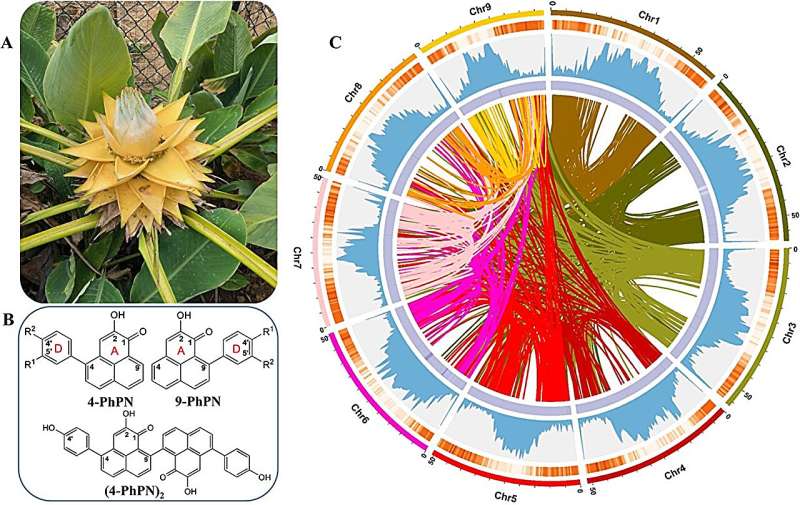This article has been reviewed according to Science X's editorial process and policies. Editors have highlighted the following attributes while ensuring the content's credibility:
fact-checked
peer-reviewed publication
proofread
Unlocking banana disease resistance: Key enzymes identified for phytoalexin synthesis

Bananas are a vital crop globally, but their yields are threatened by various diseases, particularly banana fusarium wilt caused by Fusarium oxysporum. Traditional control methods, including chemical pesticides, pose environmental risks and are not always effective.
Wild banana relatives, which possess greater genetic diversity and higher concentrations of defense-related compounds, offer potential solutions. Based on these challenges, further research into the genetic mechanisms behind banana disease resistance is essential.
Researchers from the Jiangsu Key Laboratory for the Research and Utilization of Plant Resources and collaborators have published the study in Horticulture Research.
They assembled a nearly gapless genome of Musella lasiocarpa, a wild banana relative, to investigate the biosynthesis of phenylphenalenone (PhPN) phytoalexins. This study identified three novel O-methyltransferases (OMTs) involved in enhancing the antifungal properties of these compounds, paving the way for developing disease-resistant banana varieties.
The study focused on the biosynthesis pathway of PhPN phytoalexins, which are natural defense compounds in bananas. Using advanced genomic techniques, the team assembled a high-quality, nearly complete genome of Musella lasiocarpa. They integrated transcriptomic and metabolomic data to identify candidate genes involved in PhPN biosynthesis.
Through phylogenetic analysis and in vitro enzymatic assays, three novel OMTs were characterized. These enzymes, Ml01G0494, Ml04G2958, and Ml08G0855, showed significant roles in the methylation modification of PhPNs, enhancing their antifungal activity against Fusarium oxysporum.
Ml08G0855, in particular, was found to be a multifunctional enzyme targeting multiple hydroxyl groups in PhPN structures. The study also revealed that the methylation of PhPNs significantly boosts their antifungal properties, providing a potential genetic resource for improving disease resistance in bananas through molecular breeding.
Dr. Yu Chen, one of the corresponding authors, stated, "This research provides crucial insights into the genetic basis of disease resistance in bananas. By understanding and leveraging the biosynthetic pathways of phenylphenalenone phytoalexins, we can develop more resilient banana cultivars, ensuring better crop yields and sustainability in the face of increasing agricultural challenges."
The application of this research is twofold: it offers a direct application in banana breeding programs to enhance disease resistance through molecular techniques and provides a foundation for further studies into the role of phytoalexins in plant-pathogen interactions.
The implications are far-reaching, potentially leading to the cultivation of hardier banana varieties that can withstand climate change-induced stress and reduce the environmental impact of disease management practices.
More information: Wanli Zhao et al, Characterization of O-methyltransferases in the biosynthesis of phenylphenalenone phytoalexins based on the telomere-to-telomere gapless genome of Musella lasiocarpa, Horticulture Research (2024). DOI: 10.1093/hr/uhae042
Journal information: Horticulture Research
Provided by TranSpread


















